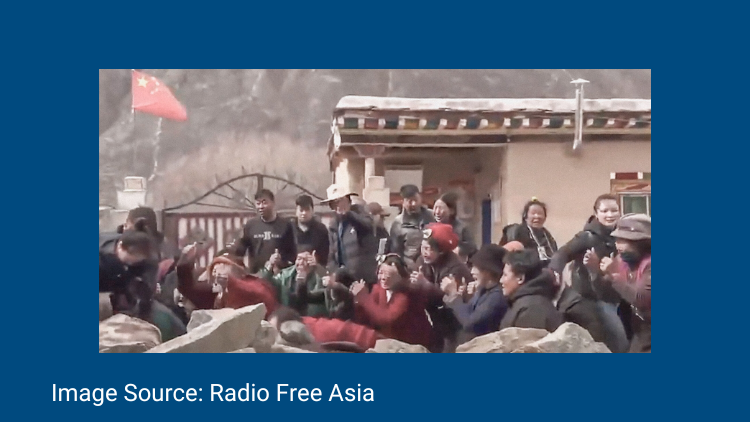Press Statement
Protests against a planned dam and resettlement project in Tibet

Drichu River Protest.
© Image Source: Radio Free Asia
"The Friedrich Naumann Foundation for Freedom stands deeply troubled by the recent arrests of Tibetan individuals peacefully protesting against the construction of a dam on the Drichu River. We strongly urge the Chinese authorities to immediately release the detained Tibetan monks and villagers, who were simply exercising their fundamental right to peaceful dissent against the dam construction."In February 2024, Tibetans, Tibet supporters and concerned observers across the globe were taken aback by leaked videos and images of Dege in the Tibetan Autonomous Prefecture in Sichuan Kham Province in China, the footage chronicling the protests against the hydropower project over the Drichu River. In some of this footage, Tibetan residents of Dege were seen pleading with Chinese officials, many of the former falling on their knees, while other recordings showed monks and common people, gathered in peaceful protest, being physically dragged away by the police."
The Protests in Dege: Why Does It Matter?
The principal cause for these protests and the subsequent response from Beijing is the ongoing expansion of Beijing’s 13-power station hydropower project on the Drichu River (Ch: Jinsha). These hydropower projects are key to Xi Jinping’s mission of achieving a Low Carbon Economy and fueling China’s increasing industrialization. The construction of the 217-meter-high Gungtao dam over the upper reaches of the Drichu River, a key component of the Drichu Hydropower Project, is being undertaken by a company called the Huadian Drichu River Hydropower Development Co. Ltd.
The imposition of adverse policies on Tibetans inside Tibet by Beijing, the resulting protests and subsequent measures to quell such expressions of dissent, all evident in the case of the Dege anti-Hydropower project protests, are a recurrent feature of the tumultuous relationship between Tibet and China.
China has constantly argued that these projects (such as that over the Drichu river) are necessary for the material development of the people, the ecology of the region and the use of renewable resources (Xinhua 2019). However, the reality is that these infrastructural commitments will have a negative impact on the livelihood, culture and heritage of people living in Dege. Once completed, the dam could result in the displacement of two villages (Upper Wonto and Shipa) and six monasteries including the Wonto Monastery, whose murals date back to the 13th century. It could also result in the displacement of thousands of residents from their ancestral lands (Lodoe and Pema, 2024), whilst affecting the ecological balance of the regions that were impacted by two major flooding incidents in 2018.
Since February 14, 2024, Tibetans in Dege have been protesting the dam's construction. In response, the Chinese government has detained more than a thousand Tibetans in Dege and imposed a curfew on several villages while censuring all mentions of Dege, the dam and the protests on social media platforms. All roads are closed, and strict restrictions are in place in the area. Seven monasteries, like Wonto, Yena and Khardho on the east bank, and Rabten, Gonsar, Tashi and Pharok on the west bank of the river in Dege, are currently under lockdown to prevent more protests. The movement of monks in these monasteries is under heavy surveillance and communication is constantly monitored (Pelbar, and Lodo, 2024).
However, acts of resistance have erupted often in Tibet over more than six decades of Chinese rule. In 2008, the Tibetan Plateau was rocked by a series of pan-Tibetan protests that marred Beijing’s efforts to promote itself as a global, normative leader; hosting the Olympics was China's means to this end (BBC, 2010). The International Campaign for Tibet reported that there have been more than 150 incidents of self-immolation in a show of drastic defiance against Beijing (International Campaign For Tibet, 2022).
Therefore, the recent protests in Dege need to be seen in the context of this long resistance against Chinese occupation and the repressive policies that China imposes to maintain its rule over the Tibetan people.
